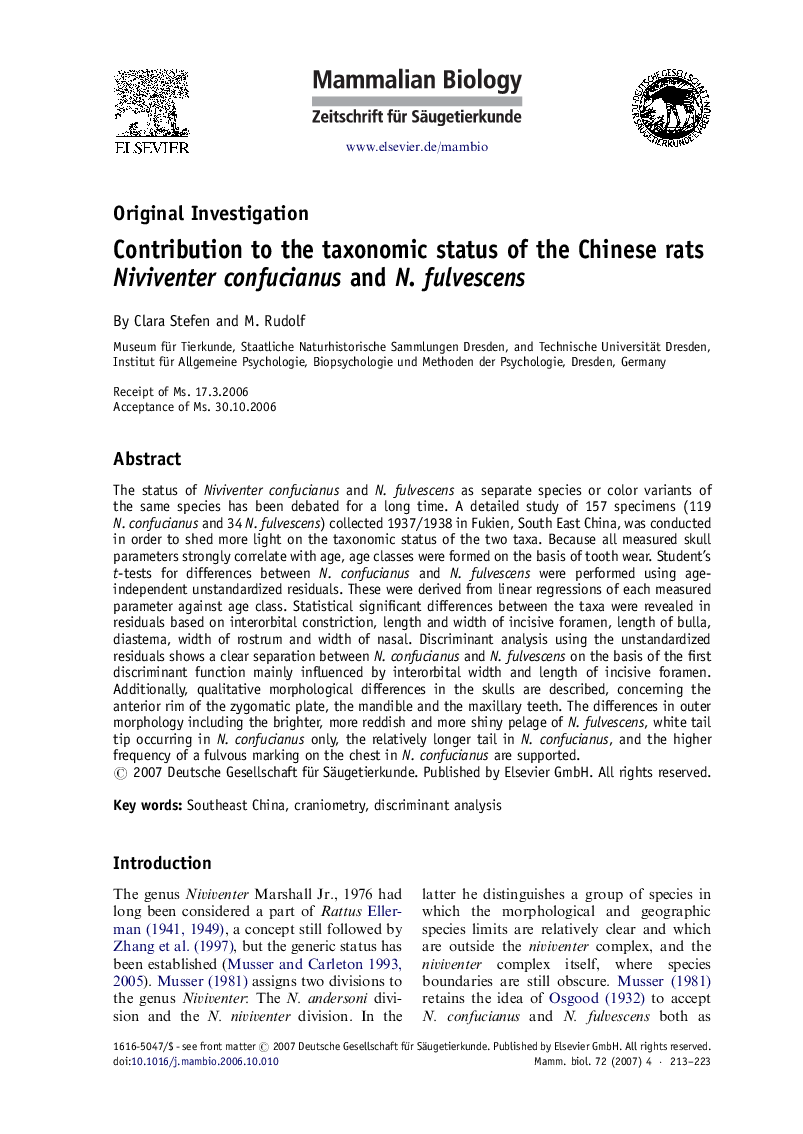| کد مقاله | کد نشریه | سال انتشار | مقاله انگلیسی | نسخه تمام متن |
|---|---|---|---|---|
| 2194447 | 1098447 | 2007 | 11 صفحه PDF | دانلود رایگان |

The status of Niviventer confucianus and N. fulvescens as separate species or color variants of the same species has been debated for a long time. A detailed study of 157 specimens (119 N. confucianus and 34 N. fulvescens) collected 1937/1938 in Fukien, South East China, was conducted in order to shed more light on the taxonomic status of the two taxa. Because all measured skull parameters strongly correlate with age, age classes were formed on the basis of tooth wear. Student's t-tests for differences between N. confucianus and N. fulvescens were performed using age-independent unstandardized residuals. These were derived from linear regressions of each measured parameter against age class. Statistical significant differences between the taxa were revealed in residuals based on interorbital constriction, length and width of incisive foramen, length of bulla, diastema, width of rostrum and width of nasal. Discriminant analysis using the unstandardized residuals shows a clear separation between N. confucianus and N. fulvescens on the basis of the first discriminant function mainly influenced by interorbital width and length of incisive foramen. Additionally, qualitative morphological differences in the skulls are described, concerning the anterior rim of the zygomatic plate, the mandible and the maxillary teeth. The differences in outer morphology including the brighter, more reddish and more shiny pelage of N. fulvescens, white tail tip occurring in N. confucianus only, the relatively longer tail in N. confucianus, and the higher frequency of a fulvous marking on the chest in N. confucianus are supported.
ZusammenfassungBeitrag zum taxonomischen Status der chinesischen Ratten Niviventer confucianus und N. fulvescensDer taxonomische Status von Niviventer confucianus und N. fulvescens als eigenständige Arten oder Farbvarianten der selben Art ist lang debattiert worden. Eine Studie an 157 Exemplaren (119 N. confucianus and 34 N. fulvescens), die 1937/1938 in Fukien, Südost-China gesammelt wurden, ist durchgeführt worden, um den taxonomischen Status der Taxa besser zu verstehen. Da alle gemessenen Schädelparameter stark mit dem Alter korrelieren, wurden Altersklassen auf der Basis der Zahnabnutzung gebildet. Student's t-tests auf Unterschiede zwischen N. confucianus und N. fulvescens sind anhand von altersunabhängigen unstandardisierten Residuen durchgeführt worden. Die Residuen wurden durch lineare Regression jedes Messparameters gegen die Altersklasse gewonnen. Statistisch signifikante Unterschiede zwischen den Taxa zeigen sich in den Residuen, die sich von der Breite der Interorbitaleinschnürung, der Länge und Breite der Incisiv Foramen, Länge der Bulla, Diastema, Breite der Schnauze und Breite der Nasale ableiten.Eine Diskriminanzanalyse mit den altersunabhänigen Residuen zeigt eine deutliche Trennung zwischen N. confucianus und N. fulvescens auf der Basis der ersten Funktion, die hauptsächlich von der Breite des Rostrums und der Breite der Interorbitaleinschnürung beeinflußt wird. Zusätzlich sind qualitative morphologische Unterschiede im Schädel beschrieben, die den anterioren Rand der zygomatischen Platte, die Mandibel und die maxillaren Zähne betreffen. Unterschiede in der äußeren Morphologie, wie das stärker rötliche und glänzende Fell von N. fulvescens, die bei N. confucianus vorkommende weiße Schwanzspitze, der relativ längere Schwanz und die deutlich höhere Frequenz von einer gelblichen Markierung auf der Brust in N. confucianus wurden bestätigt.
Journal: Mammalian Biology - Zeitschrift für Säugetierkunde - Volume 72, Issue 4, 20 July 2007, Pages 213–223